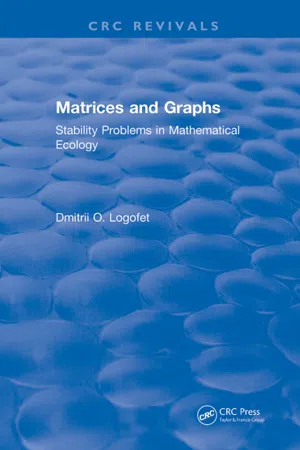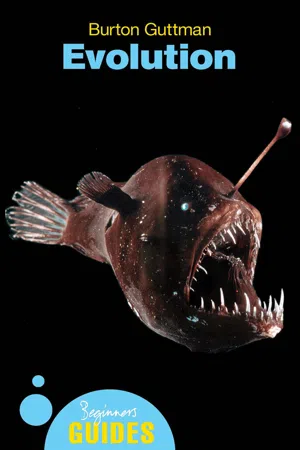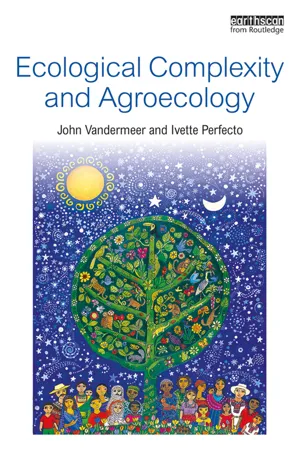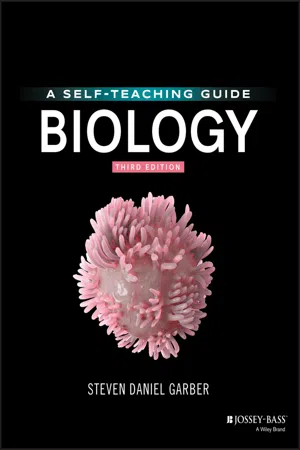Biological Sciences
Ecological Niche
An ecological niche refers to the role and position of a species within its environment, including its interactions with both biotic and abiotic factors. It encompasses the resources a species uses, its interactions with other species, and its impact on the ecosystem. Essentially, it describes how an organism fits into its ecological community.
Written by Perlego with AI-assistance
Related key terms
6 Key excerpts on "Ecological Niche"
- D. Logofet(Author)
- 2018(Publication Date)
- CRC Press(Publisher)
I. Ecological Niche and the Dynamic Equations for Competitive SpeciesSince the models in this chapter are deliberately confined to a single trophic level, they do not focus on the resource dynamics explicitly, but rely instead upon the notion of Ecological Niche, which treats the resources implicitly and in static rather than dynamic terms. This notion follows logically from the simple and straightforward idea that organisms of any biological species are characterized by a certain range of physical and ecological conditions within which they survive and successfully reproduce. Ecological Niche is therefore that domain in the space of vitally important environmental factors (for example, the specific composition and size of food, site conditions, etc.) within which the existence of the species is ensured and beyond which this existence is impossible or unlikely.1Despite this concept being intuitively clear, there is still some discussion in the literature2 , 3 about what should be an unambiguous definition of the niche. However, there is no doubt that each species occupies its own Ecological Niche, while the niches of species coexisting in real communities are typically observed to intersect, or to overlap, with each other. Species may coexist, not only by cohabiting the same or similar physical and geographical conditions, but also by consuming some resources in common. Resource limitation imposes natural constraints on the total population sizes of species sharing the resource, so that the population growth rates are mutually restricted. Ecological Niche overlap thus naturally results in relations of competition, and the Ecological Niche naturally determines the place and role of a given species in the structure of a competitive community.Since competitive communities cannot be qualitatively stable (cf. Section 5.II.C), the problem arises of determining stability domains for the parameters of a competition model, or in other words, to determine a structure of niche overlap which provides for the stable coexistence of competitors, the so-called species packing.- eBook - ePub
Evolution
A Beginner's Guide
- Burton Guttman(Author)
- 2005(Publication Date)
- Oneworld Publications(Publisher)
Dice defined a niche as a species’s ecologic position in a particular ecosystem, rather than in its community, and wrote that the term includes “a consideration of the habitat that the species concerned occupies for shelter, for breeding sites, and for other activities, the food that it eats, and all the other features of the ecosystem that it utilizes.” However, these conceptions contrast sharply with that of G. E. Hutchinson, who conceived of a niche as an n -dimensional space that specifies the total range of conditions in which the organism is able to live and reproduce; for instance, Figure 5.1 shows how an aquatic animal might occupy a niche defined by the factors of temperature, salinity, and the concentration of calcium. (Some biologists might feel that this “space” is more like a definition of habitat than of niche.) Finally, G. L. Clarke, in 1954, distinguished “functional niche” from “place niche.” He noted that different species of plants and animals fulfill different functions in the ecological complex and that the same functional niche may be filled by quite different species in different geographical regions. Although a full description of the niche of any species may be impossible, some brief examples can make the idea clearer. american robin One of the best-known birds in North America, its niche is that of a generalist in many habitats: forests, woodlands, gardens, parks, expanding into the grasslands. It feeds on fruit and on small invertebrates, including insects, largely by moving slowly over the ground and gleaning whatever it can find that is edible. It nests primarily in deciduous trees, at moderate heights, and some individuals, especially young birds still in the nest, serve as food for predators such as crows and hawks. Figure 5.1 According to Hutchinson’s conception, a niche might be a region in an abstract space defined by several factors – three, in this example - eBook - ePub
- John Vandermeer, Ivette Perfecto(Authors)
- 2017(Publication Date)
- Routledge(Publisher)
6 mainly because it is difficult to define or measure precisely, both ecologists and farmers (as well as international political commentators) regularly use the concept, if not the actual term, niche. An organism somehow has a place in the world, and that place is somehow its Ecological Niche. Minimally as historical artifact, but probably more importantly as a main foundation for the science of ecology, the concept at least needs to be acknowledged. From the niche a plant occupies to photosynthesize, to the niche of bacteria promoting the transformation of ammonium to nitrate, to the niche of an herbivorous pest, to the niche of the predator of that herbivore, it is frequently useful to engage in “niche talk.”A plausible argument can be made that Darwin was the first to articulate the idea of the Ecological Niche, although he never used the term. On the other hand, we have spoken to many traditional farmers who say pretty much the same thing. A species of plant or animal, or fungus or bacterium for that matter, seems to have a place in the overall natural system. At one level the idea is pretty trivial – corals live in coral reefs, trees live in forests and so forth. But there is something more profound, recognized by both Darwin and many traditional farmers. There are particular conditions required for a species of crop to grow, and knowing what those conditions are enables the farmer to choose what crops to grow. There are particular conditions required for a particular pest to prosper, and knowing what those conditions are enables the farmer to avoid them. These conditions, in modern parlance, define the limits of the Ecological Niche of that pest or that crop.The idea gained scientific legitimacy through the work of two field ecologists, and, not surprisingly, took on slightly different connotations for both of them. One of the acknowledged founders of the Western tradition in ecology was American ecologist Joseph Grinnell, who conceptualized the niche as a kind of physico-chemical envelope within which the species could exist. Taking a slightly different perspective, British ecologist Charles Elton had the idea that a species had some sort of a “role” to play in the ecosystem. Elton’s conceptualization of the niche reflected more modern ideas such as “response and effect”7 or niche construction.8 - Gabrielle I. Edwards, Cynthia Pfirrmann(Authors)
- 2021(Publication Date)
- Barrons Educational Services(Publisher)
18ECOLOGY
WHAT YOU WILL LEARN
In this chapter, you will explore the interrelationships among living things and the factors in the nonliving environment that affect life. You will also learn how living things can change the environment.SECTIONS IN THIS CHAPTER•The Concept of the Ecosystem•Energy Flow in an Ecosystem•Biogeochemical Cycles•The Limiting Factor Concept•Greenhouse Effect•Global Warming•Ecological Succession•World Biomes•Humans and the Biosphere•Conservation•Review Exercises•Connecting to Life/Job Skills•Chronology of Famous Names in BiologyOVERVIEW
Ecology is the science that studies the interrelationships between living species and their physical environment. The word ecology was coined in 1869 by the German zoologist Ernst Haeckel to emphasize the importance of the environment in which living things function. The environment includes living or biotic factors and nonliving factors, referred to as abiotic factors.The abiotic factors consist of physical and chemical conditions that affect the ability of a given species to live and reproduce in a particular place. Included in the abiotic factors are temperature, light, water, oxygen, pH (acid-base balance) of soil, type of substrate, and the availability of minerals. Certain kinds of plants and animals will flourish in a natural community if the conditions are present that permit their survival. Species interact to influence the survival of one another. One important principle of ecology is that no living organism is independent of other organisms or of the physical environment, if they share the same community.The Concept of the Ecosystem
Certain terms are used in ecology to provide a consistent description of conditions and events. A population refers to all of the members of a given species that live in a particular location. For example, a beech-maple forest will contain a population of maple trees, a population of beech trees, a population of deer, and populations of other species of plants and animals. All of the plant and animal populations living and interacting in a given environment are known as a community- eBook - ePub
Biology
A Self-Teaching Guide
- Steven D. Garber(Author)
- 2020(Publication Date)
- Jossey-Bass(Publisher)
Having laws to save species when they become endangered sounds like a good plan, but it doesn't work. By the time a species becomes endangered, the costs involved to fix things properly are more than most societies choose to bear. As a result, endangered species management should be a last resort. It's far wiser and costs much less to act early rather than late, by setting aside large swaths of land for long-term conservation purposes. Large wildlife preservation parks should be created that are off limits for recreation. Having large parks that include recreation too is also good. Unfortunately, mixed-use parks put too great a burden on too many habitats and on too many species to ensure their survival. So it's best to create conservation parks and then leave the conservation parks wild, without logging, skiing, hiking, fishing, biking, boating, and everything else people love to do. Leave wild places alone so we don't introduce aggressive invasive species, and so we don't take the turtles, snakes, and rare flowers out (people steal things all the time), and so we don't bring seeds into wild places in the treads of the tires of the vehicles we drive. Just leave the wild places alone (maybe some open places should be maintained by cutting woody vegetation every several years, and maybe some places should be burned over occasionally). Nature knows how to manage a place far better than any landscaper, environmental protection specialist, ecologist, or wildlife biologist I've ever met.The field of ecology grew in response to our immediate need for a greater understanding about the interactions of organisms in their natural, as well as in what are increasingly, highly altered habitats. With human disturbances affecting ecosystems globally, we are creating methods to assess and remediate the effects of our actions. We also need to maintain healthy ecosystems, which can be done most easily by enabling nature to do what it does for free, when we provide enough undisturbed real estate, not just on land, but also in fresh, brackish, and salt water. In rivers, bays, on continental shelves, and in just about every habitat imaginable.This chapter is an overview of the primary ecological concepts that are presented in most introductory biology courses, as well as in the media.HABITAT AND NICHE
The physical environment affects organisms living there in many different ways. The climate, weather, and microclimates are influenced by temperature, humidity, rainfall, and other meteorological phenomena. Soils are extremely important in their effect on terrestrial habits. In addition, aquatic habitats are also affected by salinity, oxygen, and carbon dioxide in solution, pH, temperature, as well as by available minerals and by other nutrients. The amount of light penetrating through any environment is important, as are the seasonal fluctuations with regard to any of the above variables.Just as aquatic organisms are adapted to specific sets of variables, certain plants grow only on special soil types, and some animals live only in areas where there are certain associated vegetation patterns. Air quality is also important. - eBook - ePub
The New Ecology
Rethinking a Science for the Anthropocene
- Oswald Schmitz(Author)
- 2016(Publication Date)
- Princeton University Press(Publisher)
These are fundamental questions that have occupied the minds and research efforts of ecologists for decades. Ecologists have always been fundamentally occupied with understanding why there is a wide diversity of species to begin with, because it helps to reveal and understand how intricate nature really is. The New Ecology, however, is drawing an ever more scientifically fascinating portrait about how and why the intricate ways that species that have evolved and forged interdependencies with each other matter to sustainability.* * *All individuals within species have a simple game plan: contribute as many genetic copies of yourself—offspring—to future generations as you can. Playing this game successfully requires procuring the most resources possible while outwitting your competitors and enemies. Since many strategies can achieve success, different strategies can emerge—evolve—when individuals with different capabilities are pitted against each other. Hence, evolutionary and ecological processes are mutually reinforcing (not separate) processes. The whole of it can be considered an eco-evolutionary game.To illustrate what I mean, take, as a start, plants. Their strategies involve consuming raw materials like mineral nutrients and water from the soil, and carbon dioxide from the air and, stimulated by the sun’s energy, manufacturing plant tissue containing macronutrients: proteins, sugars and starches, and fats. These are the building blocks of all life. Plants allocate these building blocks to make their body parts, like stems, leaves, and roots. Plant traits like stem height and thickness, and degree of branching, determine how well a plant is able to rise upward to gather sunlight. Plant traits like the size, shape, and location of leaves on stems and branches determine how much sunlight can be gathered, and how much water can be retained. Plant traits like root length and thickness, and degree of branching, determine the amount of water and nutrients like nitrogen or phosphorus that can be drawn up from the soil. Plants can vary how much they allocate to build stems, leaves, and roots. Just as one can arrange a basic set of musical notes to create an endless variety of music compositions, plants can arrange their allocations to stems, leaves, and roots to create a dizzying variety of architectural forms and sizes. We use these architectures, or rather collectively distinctive structures, to identify them as species. They use them to maximize their success.
Learn about this page
Index pages curate the most relevant extracts from our library of academic textbooks. They’ve been created using an in-house natural language model (NLM), each adding context and meaning to key research topics.





